![]()
Operation ID
Did you think your teacher was just nagging ... turns out marking your stuff makes it possible for it to be returned. |
Burglary is one of the most frequently committed crimes in the United States. Wouldn’t it be great if someone thought up a nation-wide system that allows citizens to help law enforcement catch thieves while also protecting their own property? Well, good news for you, I have made it my own personal mission to do just that.
Oh… umm… I guess that’s already been done. That’s embarrassing!
Ok, ok… so now I’ve made it my new personal mission to inform you of this clever system. It goes by the name of… (Drum roll please)…
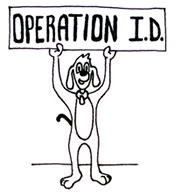
Operation ID is a program, originating in New York, that has spread throughout the nation because of its great success. The purpose of Operation ID is to deter theft through branding products, making it difficult for thieves to resell stolen property and increasing the likelihood of the criminal being caught. If a thief is aware of the use of Operation ID in a particular neighborhood, he will most likely leave your community alone (unless he enjoys patty-wagon rides and striped pajamas). The use of this inventive branding system allows authorities to identify the property as stolen, prosecute the criminal, and return the goods to the rightful owner from anywhere in the country. (I wasn’t exaggerating about that nation-wide part). So, not only will you be keeping your valuables safe, you will also be helping law enforcement put criminals behind bars. What more can you ask for in an upstanding citizen?
GETTING YOUR ID NUMBER:
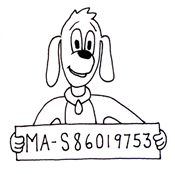
Different areas use different numbering systems, so see your local police department or your school’s safety organization for specific instructions on how to go about protecting your stuff with Operation ID. Please be aware that you should never ever use your social security number as your ID number. If you are advised to do so, I would suggest talking to someone else, ‘cause that guy’s probably looking to open credit cards in your name…Yikes! (To read more about identity theft, check out this article. It’s remarkably eye-opening.) No matter what your community’s method is, the identification number that you use is yours forever. It will not be duplicated, it will not expire, it belongs only to you.
Some communities will advise you to use your state’s abbreviation along with your driver’s license number. This would look like:
MA-S86019753
You may be provided a special number by your local police department. This number is usually devised from a two-part template. The first part of the number identifies your local precinct (such as MA013). The second part of the number identifies you (or your organization) as the individual owner of the property. This would look something like:
MA013000AP53186
Remember, different communities use different systems. The number assigned to you may not resemble the above numbers in any way. But trust in the system, because no matter the marking method, Operation ID has been successful in reducing burglary and increasing criminal apprehension in communities across the United States. (Too bad someone else thought of it before me…darn!)
THINGS TO PROTECT
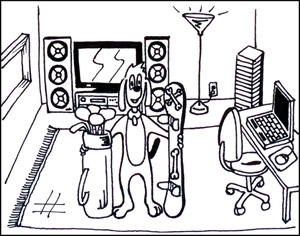
Most people only feel the need to mark one or two items (their bicycle, laptop, etc.). BUT… if you really get a kick out of using this engraving-thingy, think about marking this stuff too:
| Televisions | Power Tools | Watches |
| Stereo Equipment | Computers | iPods/ MP3 Players |
| Car Radio Systems | Monitors | Calculators |
| Golf Clubs | Peripherals | Lawn Movers |
| Fishing Rods | Cell Phones | Snow Blowers |
| CD/DVD Players | Camera | Anything You Value! |
| Appliances | AV Equipment |
MARKING YOUR STUFF:
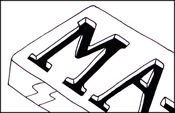
Engraving tools are available at your local hardware store. But before you go purchasing one, I’d check with your local safety department first. A lot of times, the police station or library will have one that you can borrow. More often than not, schools and universities will have some available for students to check out. But, if you’re a big spender and find yourself buying those gizmos on a regular basis, it may be worth it to pay the few bucks for your very own engraver so you can have it on hand. But you’ll probably want to engrave that engraver so it doesn’t get stolen, so you’ll need to buy an additional engraver as well. (Hey, at least it’ll help expand your collection of doohickeys and thingamabobs.)
Before you begin engraving that number on the back of your Rolex, try practicing on something a little less expensive first… perhaps that piece of junk coffee table in your garage?? Make sure to use steady, smooth strokes and take your time, there is no eraser!
Be certain to engrave your whole Operation ID number, otherwise it won’t help. Engrave the number on an area of the object that is not easily seen or removed; a thief won’t think to file down a serial number that he doesn’t notice. If your local safety department has Operation ID decals, display them prominently on the doors and other entryways to your home, which will hopefully send those thieves running away with their tails between their legs.
If you decide to sell an engraved piece of equipment, contact the person you spoke with originally about Operation ID for advice on the best way to transfer the equipment, without making the buyer look like a thief.
KEEPING A LOG:

Once you’re done engraving (for the time being, anyway), it is now time to create a log of all your marked items. This log should contain a record of the item itself along with a description of its size, color, estimated value, serial number, and engraved Operation ID number. Some places may have pre-created logs (mostly schools) that you can get and just fill in the necessary information. Create a few hard copies of this log, and keep them in separate safe places (like locked cabinets or safety deposit boxes). If any of your items are stolen, this log will be as valuable as gold dust.**
**not really, but pretty darn close!
TELLING THE COPS:
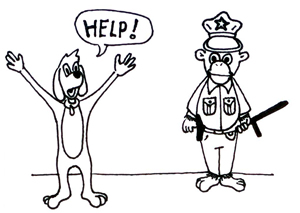
Using Operation ID can really help keep your stuff in your hands. But, if it doesn’t, please don’t call me complaining that my “new personal mission” has failed you – I don’t think I can handle that kind of rejection. Instead, call the police…it’s their job to listen when the system has failed you. A police officer is your friend, so REPORT THEFT IMMEDIATELY!! You are not Sherlock Holmes… you cannot solve crimes (unless you are a detective, then I eat my words.) Use your golden log to provide your new friend, the police officer, with all of the necessary information, including the engraved number and its location on the item. See… it IS worth the time to make a log!
Operation ID is a nationally recognized program, but it is not nationally regulated. As I said repeatedly throughout this article, every area has its own method. The article above is intended for informational purposes only, and cannot be looked at as instructions. Please Please Please… talk to your local safety department for your area’s method.
For additional ways to keep your computers, laptops, and AV equipment safe, call us at (800) 466-7636. It’s been our own personal mission to keep your equipment safe for the last 25 years.